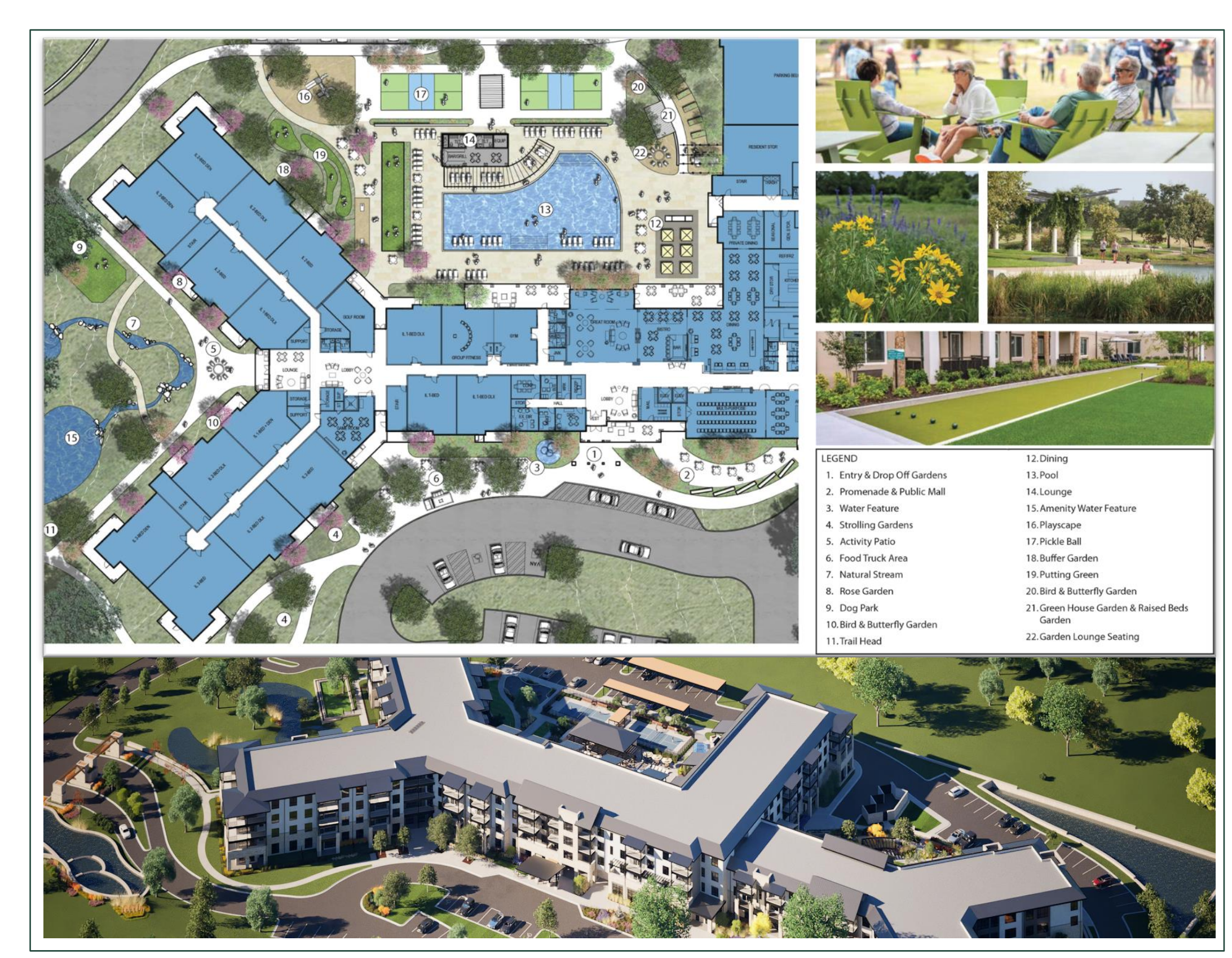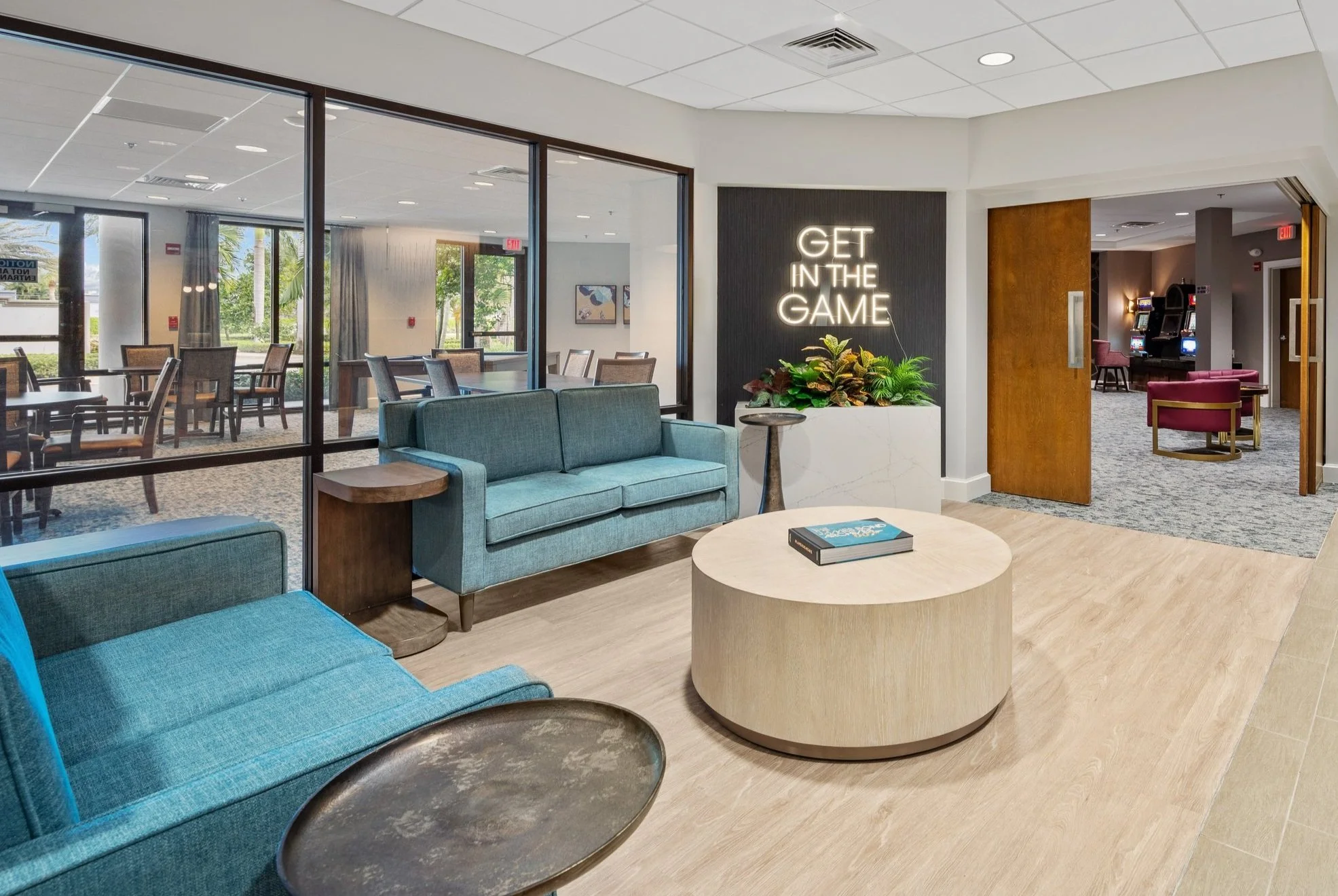Trends in Senior Living Development and Repositioning
It wasn’t that long ago when every home had a landline telephone, and cell phones were considered a luxury. Today, much of the technology that worked 20 or even 10 years ago is outdated. The same is true for senior living. Many of the amenities that used to attract residents are woefully inadequate today – a single spacious dining hall, a game room for Bingo, and a swimming pool aren’t enough to meet their needs, interests, and expectations. However, many communities have ‘good bones’ and can be repositioned or renovated for seniors today and for years to come.
Evolving Senior Expectations
Today’s seniors are more active and engaged than ever. Many are working or volunteering into their 60s, 70s, and even 80s, and they value lifestyle, purpose, and autonomy over institutional care. Seniors seek convenient access to amenities, wellness activities, and preventive health programs, preferring not to live in environments that feel like healthcare facilities or places that emphasize their age and limitations. While many seniors value time with family, they also want social engagement with peers and people of all ages.
Seniors are willing to pay for what they want, including:
Private units with quality finishes.
Convenient services (housekeeping, transportation, concierge services).
Wellness amenities such as fitness centers, pools, and therapy rooms.
Cultural/educational programming (including the ability to take courses online or at nearby colleges and universities).
Tech-enabled safety features (e.g., passive monitoring)
At the same time, there are elements/amenities they don’t value, many of which can be costly:
· Excessive dining costs with inflexible meal plans.
· Long corridors, inaccessible layouts, and oversized apartments.
· In-room emergency pull cords vs. mobile safety systems.
· Overly medicalized design cues.
· Formal amenities without everyday utility (e.g., underused theaters).
While there are some common desires and expectations, seniors don’t want cookie-cutter communities. They want a unique home where they feel heard, connected, and engaged. Any plans for repositioning should include input from residents and prospective residents about what they want in a senior community, what says “home” to them, and what barriers exist to moving into senior living.
Repositioning Audit
To determine where your limited investment dollars will have the greatest value and impact, start with a repositioning audit. Specifically, look at:
· Physical campus and infrastructure, including building age and condition, MEP systems, technology infrastructure, accessibility, exterior appeal, and indoor amenities.
· Units and residential mix, including unit size/configuration, unit features and fixtures, occupancy and turnover rates, and resident preferences.
· Commons and lifestyle programming, including dining venues, wellness and fitness facilities, branding and first impressions, and social/engagement spaces.
· Services and operational efficiency, including staffing workflow, food service operations, laundry, and energy and utility costs.
· Market alignment, including competitor benchmarking, demographic demand, untapped market segments, and community brand perception.
By assessing your opportunities for changes, updates, upgrades, and new buildings or amenities, you can prioritize where to invest and what efforts need to be addressed first. By going into an audit with an open mind, you might be surprised to discover that changes you thought you would need to make aren’t necessary, while others you haven’t considered should be top priorities. For example, you may think you need a new or bigger swimming pool, but you may find that residents want more amenities around your existing pool.
Even with limited space, you can still find opportunities for expansion. For instance, a rooftop oasis with a bar, perhaps with a dance floor and a stage for live entertainment. Expand your dining options with thematic dining, outdoor eating options, grab-n-go windows, and food trucks or pop-up eateries.
My Generation, Your Generation
In one survey, 95% of seniors said they believe intergenerational living/programming should be a priority for senior living communities. This isn’t surprising as intergenerational living has become increasingly popular in recent years. Nationwide, nearly 60 million Americans live in intergenerational homes. The most successful intergenerational communities balance common areas with private spaces. Soundproofing between spaces and separate entrances can enhance residents’ ability to control their environments.
Smart home technology is key to successful intergenerational living. The challenge is to find devices and amenities that are cutting-edge enough to satisfy younger residents while employing the ease of use that older residents have come to expect. Increasingly, technology enables safety, security, comfort, communication, and access to entertainment. Technology also helps save energy, which people in different age groups say is important to them. Services like maintenance and landscaping may be part of a monthly fee or purchased à la carte.
Trends Attract More Seniors
Forward-thinking senior living communities are implementing some of the hot trends for seniors. These include:
· Active adult cottages. These are designed to offer comfort and convenience in a maintenance-free environment. They generally provide more space without the shared walls of apartment living. Cottages use space efficiently, with a single-story layout and features such as private entrances, open floor plans, a full kitchen, and outdoor space such as a patio, garden, or small yard. Services such as maintenance and landscaping may be part of a monthly fee or offered à la carte. Cottage residents enjoy a private retreat while maintaining access to the benefits of communal spaces and amenities.
· Pocket communities. These generally involve a cluster of homes grouped around a shared space such as a courtyard. These are designed to enable easy interaction and a sense of community. This is especially appealing for residents who want neighbors who are also friends and who enjoy common interests, activities, and a desire to share things like rides and meals. Houses in these communities tend to be smaller and often environmentally friendly. They usually have smaller parking areas and encourage/enable walking and socializing.
· Satellite communities. These are smaller communities near a larger one and present a way to increase occupancy to meet growing demands. Like pocket communities and cottages, satellite residents generally have access to the amenities of a larger campus. However, they may have some dedicated amenities like dining or fitness. Transportation – via shuttles or golf carts – should be available for ease of transit between the satellite community and the larger campus.
· Longevity communities. These are communities that focus on the residents' quality of life. These communities often emphasize the importance of social connections, health, and well-being.
Aligning the Environment and Economics
Instead of fighting or countering the environment around a community, it makes practical and economic sense to integrate efforts that accommodate the space around it. Take the example of Babcock Ranch in Florida. The town was designed to accommodate the state’s climate and ecosystems with indigenous plants and natural waterways for drainage. It was built 25 to 30 feet above sea level to help mitigate flooding from storm surges. There are sustainable water and sewage systems, and all electric and phone lines are buried. It is also the first solar-powered town in the country, with a solar field of 150 megawatts. As a result of all this, the town emerged almost unscathed after Hurricane Ian, when so many other towns and cities were devastated and millions lost power and/or water.
Senior living communities can follow this example to some degree. For instance, those in states where long, cold winters are common will want to employ covered walkways and outdoor spaces that can be easily heated and are shielded from the cold and winds. Communities in areas where flooding is a risk need to have ways to limit water damage, power loss, and the need for evacuations.
Of course, there is more to community design than the homes and buildings. Curb appeal and amenities are important, but buildings need to appeal to residents’ interests, tastes, and experiences. For instance, regional art and a nod to local colleges, sports teams, industries, attractions, etc., with photographs, artwork, colors, and even furniture can appeal to local pride and appreciation of regional heritage. Examples include furniture made at a local factory or from local wood, a fireplace using stones from a local quarry, or a dining space with historic photos of area farms, restaurants, etc.
Don’t forget the fun. Vintage art and design elements that hark back to happy times for residents, and nostalgia in general, are popular to some degree, for instance, a coffee shop with a ‘50s diner look or a media room with vintage movie posters. Biophilic design elements that bring in nature – whether that means plants or floral arrangements, fountains, aviaries – are increasingly popular, as are rooms that provide panoramic views of the outdoors, screened porches or rooms that open onto a patio or courtyard, and natural elements in furniture and art.
There are some exciting opportunities for senior living development and repositioning, even when budgets are tight and space is limited. Blending creativity, technology, innovative design, and practical solutions can pave the way for communities where seniors and others want to live and work.
Pi Architects | Contact us here or call us at 512-231-1910.








